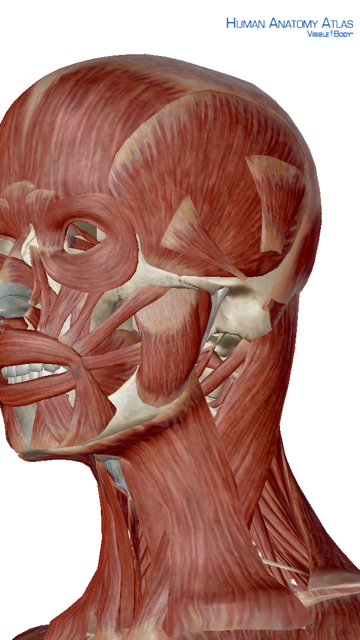"Open your mouth a little, and continue doing the movement."
This is one of Mia Segal's mantras when teaching Awareness Through Movement. During a workshop she led in Seattle this past week, she explained that she asks her students to pay almost as much attention to their jaw as to their breathing, because they both hold a huge amount of control over how you move. There are muscles in your jaw that run under your jaw deep into your neck, others that run back to your ears, and others that run up towards the top of your head. If all of those muscles are busy holding your jaw shut tight, they can seriously limit the mobility of your head and neck, and cause headaches.
In this illustration, you can see the muscles that connect the jaw and neck, and jaw and head. (Courtesy of Visible Body App)
After a day in her workshop where we worked with neck and spine mobility, while being asked to keep our jaw soft, I made a discovery: There's a connection in my own body between the pain I feel occasionally in the left side of the back of my neck and tension I hold under the left side of my jaw.
I wrote a post about it on Facebook, and someone left a comment: "I have that too! What do you recommend?" I left a short answer there, but realized this would make for a great blog post topic, so here comes a longer answer.
How do you hold your jaw?
We all have to hold our jaw up all day long. If we didn't, we'd walk around with our mouths wide open and look really silly. However, because it's something we do all day every day, it's something we don't notice.
Notice how you are currently holding your mouth closed. Are you clenching your teeth? Is your tongue resting on the bottom of your mouth or are you holding tension there too?
Intentionally clench your teeth. Do you feel more pressure on one side than the other? That's the side you carry more tension in. (For me, consistent with my left side neck pain, it is VERY easy for me to clench the left side of my jaw.)
Next, gently open your mouth. Does one side open further or more easily than the other? You can put your hands on your jaw for reference and see if one hand moves more or faster than the other. (For me, again consistent with my neck and where I clench my teeth, the right side of my jaw can open more easily than the left.)
Now, using your hands as guides, see how evenly you can open and close your mouth, so that both sides move the same amount and at the same speed. You'll find that muscles under your jaw, around your ears, and in your cheeks need to behave differently to even out the movement. You also may feel like the side of your jaw that usually stays tight is hanging wide open, or that the muscles around it are sore. Those sensations are okay.
Finally, simply close your mouth again and see how you want to hold it closed. Are your teeth touching, or are you choosing to close your lips around your open teeth?
Coordinating Jaw, Neck, and Head Muscles
Your jaw muscles have a huge amount of control over the rest of your head and neck. Here's an example: clench your teeth and turn your head. Notice how far your can turn your head, how easily, and how much tension automatically builds up around your temples. Open your mouth a little and turn your head again. You'll find you can turn your head farther and more easily, and that the tension in your temples softens.
With your mouth open a little, draw a small, slow circle with the top of your head, allowing your head to roll around your atlas (the very top vertebra under your skull). See how round you can make the circle, and keep your jaw soft the whole time.
(Congratulations! You just did a mini Awareness Through Movement lesson!)

